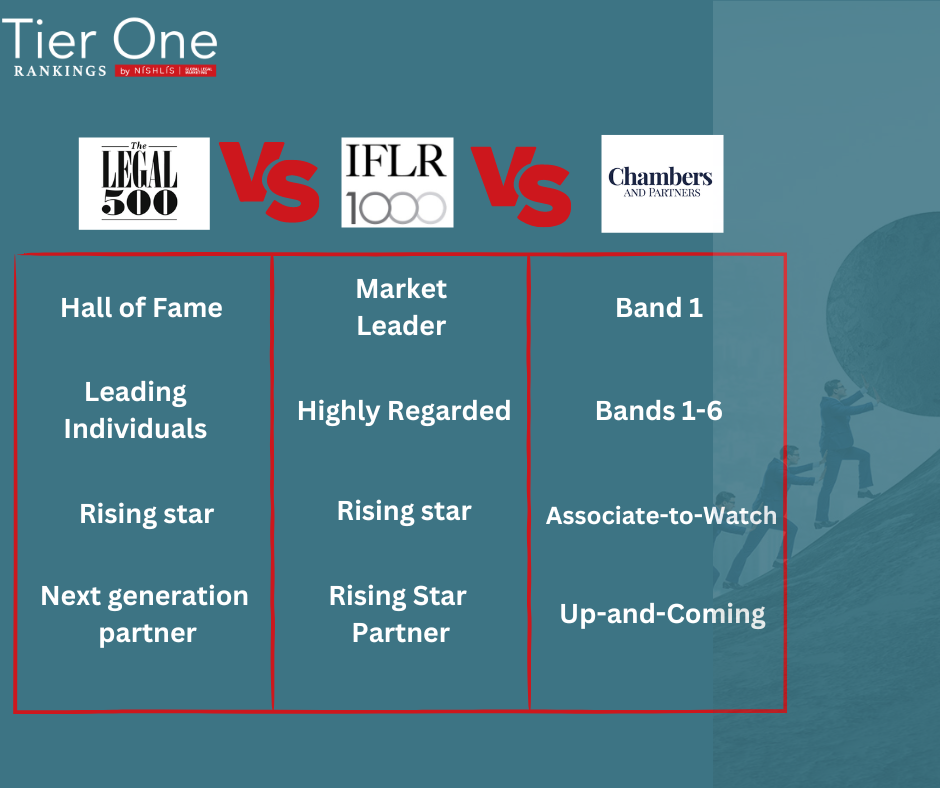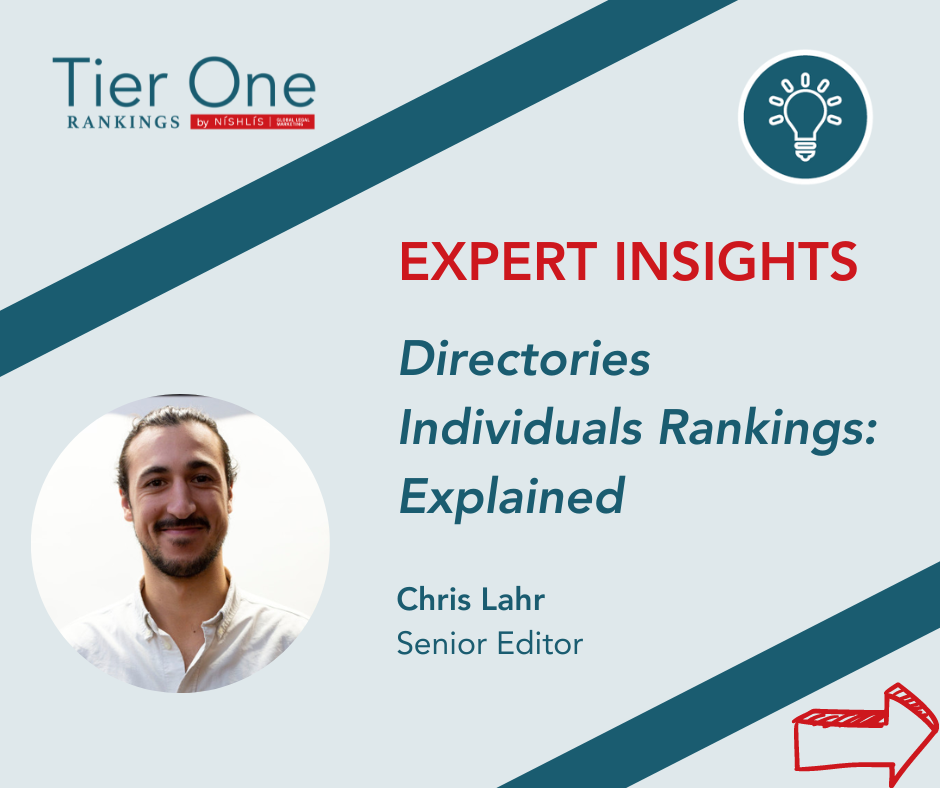With the launch of the 2024 Chambers and Legal 500 EMEA guides, now seems like an excellent time for a quick refresher course on the individual rankings and differences between the guides. First things first, you will find below a list of the individual rankings and how they are awarded:
Legal 500 Individual Rankings
Hall of Fame – To be considered eligible for the Hall of Fame, lawyers must be widely regarded as being at the very top of the profession, and to have been consistently ranked as leading individuals by The Legal 500 for a number of years. While in the past, elevation to the Hall of Fame was determined purely by reaching the requisite number of years as a leading individual, inclusion is now down to editor discretion.
Leading individuals – Leading individuals are defined as true market leaders, with long-established reputations in their sector, lead roles in multiple recent significant matters, and exceptional, widespread recognition and endorsement from peers in the market and clients alike.
Next generation partners – These individuals are lawyers with (generally) five years or fewer at partner level, significant recognition from clients and peers in the market, and recent lead roles on multiple matters.
Rising stars – Rising stars are defined as associate-level lawyers who appear frequently in significant matters and are widely cited by peers and/or clients as having made major contributions to practices.
Recommended individuals – All individuals mentioned in the editorial, either in firm write-ups, client testimonials, as heads of practice or other key lawyer listings, should be regarded as recommended lawyers in The Legal 500.
Chambers Individual Rankings
Bands 1-6 – Individual lawyers are ranked in bands from 1 (highest) to 6 (lowest). Being ranked in any band is a significant achievement which recognises the individual as a standout in their field.
Senior Statesperson – A lawyer who no longer works hands-on with the same intensity but who, by virtue of close links with major clients, remains pivotal to the firms success. This ranking is generally only granted to those who have reached the highest Band rankings.
Eminent Practitioner – Highly influential lawyers in a particular practice area who, due to managerial or client relationship commitments, are less active in fee-earning work but remain key players in the team. This ranking is generally only granted to those who have reached the highest Band rankings.
Star – This ranking is given to lawyers with exceptional recommendations in their field. Keep in mind that there can only be one Star in any ranking table, and often there are none.
Up-and-Coming – Lists those who do not yet have an established reputation to match those in ranked in the Bands but who are driving their firm’s growth.
Associate-to-Watch – Senior associates who are recognised for their work in the background of major deals.
Star Associate – Awarded to an associate who consistently demonstrates an outstanding degree of technical and commercial expertise beyond that of their peers. As with the Star ranking, this can only be given to one individual in a ranking table and is often not awarded at all.
Spotlight – A ‘Spotlight’ ranking is given to individuals where the table does not have numerical rankings. All ‘Spotlight’ rankings are equal and the ranking serves to highlight a select group of firms or individuals. This is most often seen when highlighting a small or niche area, or a new ranking in which Chambers is still figuring out how best to structure the ranking table.
IFLR Individual Rankings
Market Leader – Partners who are the true leaders in their practice area(s) and jurisdiction in the eyes of clients and peers, with clear records of leading on the most high-profile, innovative and complex deals in their markets.
Women Leader – To be ranked Women Leader, lawyers must meet the criteria for Market Leader (stated above) or must hold high status within their market for their leadership abilities. See ‘Women Leaders’ section for more detail.
Highly Regarded – Partners who have outstanding deal records in the practice in question and are highly regarded by clients and peers.
Expert Consultant – Senior figures with name recognition who focus on consulting and building client relationships. These are individuals who may stepped back from the active client work to serve as rainmakers or figureheads for a practice.
Rising Star Partner – Lawyers who made partner relatively recently who are working on complex deals and are recommended by clients or peers. To be eligible for this rating, lawyers must have made partner within three years of the current submission deadline. Only lawyers who were promoted to partner within three years of the submission deadline are eligible for this rating.
Rising Star – Ones to watch – lawyers building their reputations in the market who are working on notable deals and are recommended by clients or peers. Only non-partners who qualified within 15 years of the submission deadline are eligible for this rating. Eligible candidates cannot have made partner and must have no more than 15 years post qualification experience.
Notable Practitioner – Lawyers supported records of advising on significant deals in the jurisdiction and practice area in question.

Whilst this may seem like a fairly sizeable glossary of different ranking terms, there are some key similarities and differences which should hopefully simplify what these rankings mean to you.
- Hall of Fame vs Market Leader vs Band 1: The Legal 500 Hall of Fame and IFLR Market Leader rankings are reserved for those who are widely regarded as at the top of their fields. Whilst Chambers don’t have an exact ranking criteria like these, it could be equated to longstanding Band 1 practitioners in Chambers.
- Leading Individuals vs Highly Regarded vs Bands 1-6: One of the first things you should notice when comparing these rankings is that the Legal 500 Leading Individuals lists are generally considerably shorter than the Chambers Bands rankings and IFLR Highly Regarded rankings. This is due to the fact that a Leading Individual ranking is akin to a Band 1/2 ranking in Chambers and is really only awarded to those they consider true market leaders, so do not be discouraged if you are ranked in the Chambers bands and IFLR Highly Regarded yet not in Legal 500’s Leading Individuals list!
- Up-and-Coming vs Rising Star Partner vs Next generation partner: These rankings are much the same in practice. With this ranking the directories are aiming to recognise younger partners who are making a name for themselves but have yet to achieve the recognition of those ranked as in the Bands or as a Leading Individual. It is important to note here that there is no guarantee an individual will automatically make the jump to the next ranking after they have been ranked for several years, so it is important to continue demonstrating their leading role within their practice.
- Rising star (Legal 500 & IFLR) vs Associate-to-Watch: Once again, these rankings are very much the same. These rankings are aimed at highlighting key associates within practices that are active on major deals and receive recognition from peers and/or clients.
- Expert Consultant vs Eminent Practitioner: Once again, these rankings are very much the same. You will most often see managing partners and senior partners here who are recognised as rainmakers for their practice. Legal 500 does not have an equivalent ranking.
- Recommended Lawyer vs Notable Practitioner: This ranking differs from the others in that it is how Legal 500 and IFLR recognise practices’ other key practitioners who don’t meet the criteria of the other rankings. Chambers does not have an equivalent ranking.
You may be asking why I haven’t made further mention of the Women Leader, Star, Star Associate, or Spotlight rankings, and that would be simply because each of these rankings are unique to their guides. For each of these specific recognitions you need only refer to the description provided to see how it applies to you.
Hopefully, newly armed or refreshed with this information, the guide launches will be less ambiguous and you should feel more confident as to both where you currently stand and where you hope to see yourself ranked in future editions.

